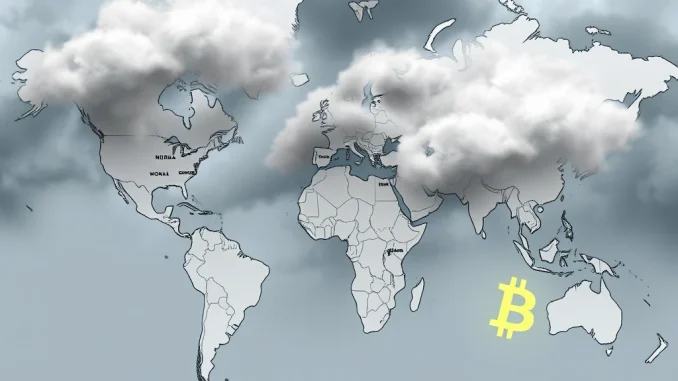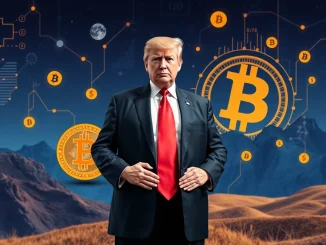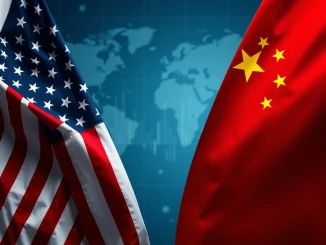
Heads up, crypto enthusiasts! The winds of economic change are blowing, and they might just ruffle the feathers of the volatile crypto market. All eyes are on April 2nd as President Trump is set to unveil a new tariff policy. While the announcement isn’t directly crypto-related, its ripple effects across global markets could spell significant changes for digital assets. Let’s dive into what this means for your crypto portfolio and the broader economic landscape.
Why Trump’s Tariff Policy is a Hot Topic Right Now
President Trump’s upcoming announcement isn’t just another day in politics; it’s a potential game-changer for global trade and the world economy. Here’s a quick rundown:
- Confirmed Announcement: The White House has officially confirmed that President Trump will reveal his new tariff policy on April 2nd. This isn’t speculation; it’s happening.
- Senior Officials Involved: Proposals have been submitted by senior officials, suggesting a well-thought-out (or at least planned) approach.
- No Exemptions: Crucially, reports indicate that these proposals currently include no exemptions. This broad-brush approach could have wider implications across various sectors.
- Market Impact Downplayed: Press Secretary Levitt is attempting to calm nerves by downplaying concerns about the market volatility that such announcements often trigger. But should we be so easily reassured?
The key takeaway here is uncertainty. Whenever tariff policy shifts, it introduces variables into the complex equation of global economics. And as we know, markets, especially the crypto market, abhor uncertainty.
Decoding the Potential Market Volatility
Why should crypto investors care about tariffs? Because tariffs are rarely isolated events. They often trigger a chain reaction. Here’s how Trump’s tariff policy could inject market volatility:
- Trade Wars and Retaliation: Tariffs can lead to retaliatory tariffs from other countries, escalating into trade wars. This disrupts established trade routes and supply chains, creating economic uncertainty.
- Inflationary Pressures: Tariffs are essentially taxes on imported goods. These costs can be passed on to consumers, leading to inflation. Inflation can erode the purchasing power of fiat currencies, potentially driving investors towards assets perceived as inflation hedges – like Bitcoin and other cryptocurrencies.
- Stock Market Fluctuations: Major tariff announcements often send ripples through the stock market. If traditional markets react negatively, it can sometimes spill over into the crypto space. While crypto is often touted as uncorrelated, broad market sentiment can still influence investor behavior.
- Currency Devaluation: In response to tariffs, countries might devalue their currencies to make their exports more competitive. Currency fluctuations can impact the value of assets, including cryptocurrencies traded against those currencies.
- Investor Sentiment Shift: Overall economic uncertainty can lead to risk-off sentiment. Investors might become more cautious and re-evaluate their portfolios, potentially leading to shifts in asset allocation, including in and out of crypto.
While Press Secretary Levitt downplays concerns, seasoned investors know that government policy shifts, especially on trade, rarely have zero impact. The lack of exemptions in the proposed tariffs suggests a potentially broad and impactful policy.
Economic Uncertainty and the Crypto Connection
Cryptocurrencies, particularly Bitcoin, are sometimes viewed as a safe haven asset, a store of value in times of economic uncertainty. When traditional markets become turbulent due to events like Trump tariffs, some investors might turn to crypto as an alternative.
However, it’s crucial to remember that the crypto market itself is known for its extreme market volatility. While tariffs might drive some investors towards crypto, they could also contribute to overall market unease, leading to sell-offs in all asset classes, including crypto.
It’s a double-edged sword. Trump tariffs could:
- Increase Crypto Appeal: As a hedge against fiat currency devaluation and traditional market downturns.
- Heighten Market Fear: Contributing to overall market volatility and potentially triggering risk-off behavior in crypto markets as well.
Navigating the Tariff Tides: Actionable Insights for Crypto Investors
So, what should crypto investors do as we approach April 2nd?
- Stay Informed: Keep a close watch on news updates regarding the tariff policy announcement. Reputable financial news sources will be crucial.
- Assess Your Portfolio Risk: Evaluate your crypto portfolio’s risk exposure. Are you comfortable with potential market volatility? Consider adjusting your holdings based on your risk tolerance.
- Diversify (Wisely): Diversification is always a good strategy. Don’t put all your eggs in one crypto basket, and consider diversifying across different asset classes if appropriate for your investment strategy.
- Prepare for Volatility: Market volatility is almost guaranteed around major economic announcements. Be prepared for potential price swings in the crypto market. Avoid panic selling and stick to your long-term investment strategy if you have one.
- Long-Term Perspective: Remember that short-term market volatility driven by news events is often just noise in the long run. Focus on the fundamental value and long-term potential of your crypto investments.
Conclusion: Prepare for Potential Crypto Market Ripples
President Trump’s April 2nd tariff policy announcement is a significant event that could inject further market volatility into the global economy, and by extension, the crypto market. While the exact impact remains to be seen, prudent crypto investors should be aware of the potential for increased economic uncertainty and market volatility. Stay informed, manage your risk, and remember that in the world of crypto, volatility is often the name of the game. April 2nd could be a day of significant market movement – are you ready?



